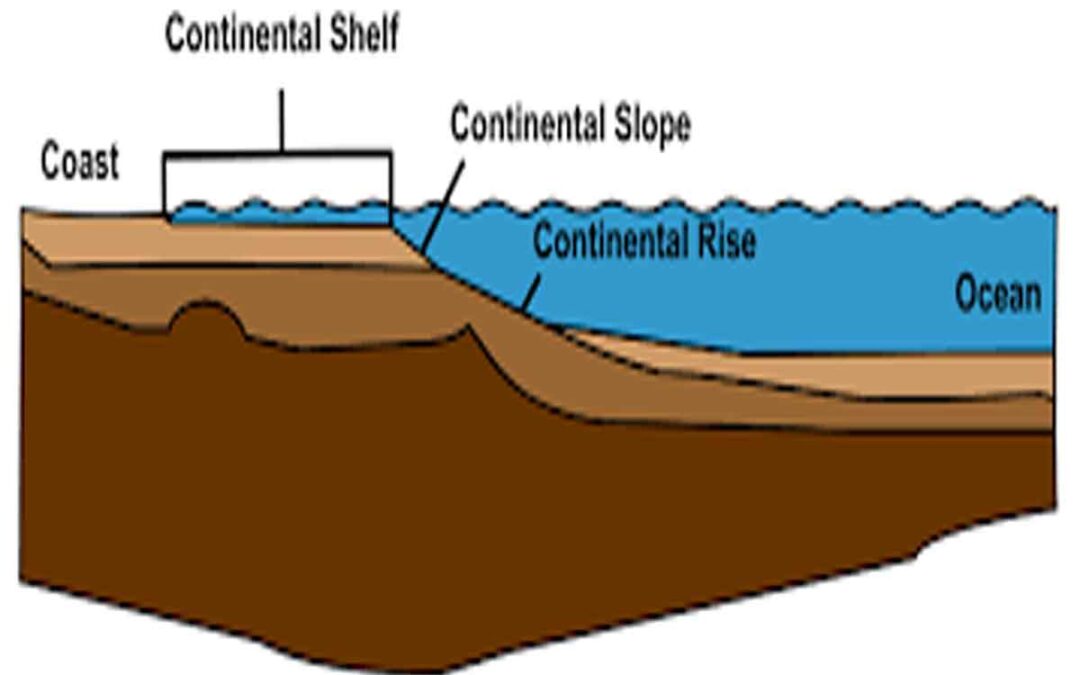The term “continental margin” refers to the transition zones between the Earth’s continental and oceanic crust. These edges play an important role in shaping the geological and ecological dynamics of the Earth.
Continental Margins:
Continental margins are shallow bodies of water near continents. It’s the zone of the ocean floor that separates the thin oceanic crust from the thick continental crust.
Types of Continental Margins:
There are two types of continental margins have been identified,
- Active continental margins
- Passive continental margins
Features of Active continental margins:

- Continental shelf
- Continental slope
- Oceanic trench
Continental shelf:
- A gently sloping water surface that runs from the shoreline to a deep sea basin.
- Usually tilted at an angle of 0.10
- On average, it is about 70 kilometers (43 miles) wide, but it varies from a few tens of meters to 1500 kilometers (930 miles)
- Have economic and political significance
Continental slope:
- Deep-sea basins begin on the continental slope
- A relatively steep slope that extends from a depth of 100 to 200 meters at the edge of the continental shelf down to the deep sea.
- The average angle of slope for a continental slope is 40 to 50, although it varies from 10 to 250
- Submarine Canyon is the most outstanding feature found on the continental slope.
Oceanic trench:
An oceanic trench is a narrow, deep trough parallel to the edge of a continent or an island arc from the deepest parts of the ocean. Most of the trenches are located on the edge of the Pacific Ocean.
Features of Passive continental margins:

- Continental shelf
- Continental slope
- Continental rise
Continental shelf:
- It is a gently sloping submerged surface extending from the shoreline towards the deep-ocean basin
- Typically inclined at an angle of 0.10
- On average, it is about 70 kilometers (43 miles) wide; build varies from a few tens of meters to 1500 kilometers (930 miles)
- Have economic and political significance
Continental slope:
- Deep-sea basins begin on the continental slope
- A relatively steep slope extending from 100 to 200 meters at the edge of the continental shelf down to the deep sea.
- The average angle of slope for a continental slope is 40 to 50, although it varies from 10 to 250
- Submarine Canyon is the most outstanding feature found on the continental slope.
Continental rise:
- The continental rise is a transition zone between the continental margin and the deep-ocean floor.
- It consists of a huge pile of rubble lying under the water.
- The material transported by turbidity currents is responsible for the creation of continental rises.
- The slope angle decreases, and the turbidity current slows, causing suspended material to settle out in a distinctive type of layering called grabbed bedding.
Difference between active continental margin and passive continental margin:
The difference between the active continental margin and the passive continental margin is given below,
| Active continental margin | Passive continental margin |
| Typically characterized by earthquakes and a young mountain belt and volcanoes on land. | Passive margins are not situated along an active plate boundary. |
| Frequent tectonic activity | Less/ no tectonic activity |
| Here, weathered materials eroded from the adjacent landmass accumulate, forming a thick, broad wedge of relatively undisturbed sediments. | It usually lacks a continental rise and an abyssal plain and is associated with convergent plate boundaries. |
| Passive margins are found along most coastal areas surrounding the Atlantic and Indian oceans. | It is found on the edge of most of the landmasses bordering the Pacific Ocean. |
Importance of Continental Margins:
Continental margins are extremely important for several reasons:
Natural resource exploration: These areas are rich in resources such as oil, natural gas, and minerals.
Marine ecosystems: These areas provide important habitats for a variety of marine life, including vibrant coral reefs and thriving fishing grounds.
Global climate system: Continental margins play a key role in storing carbon and shaping ocean circulation patterns.
Conclusion:
Continental margins are of great importance for understanding the geology and ecology of the Earth. Their dynamic nature makes them a focus for the study of natural processes and the search for raw materials. These areas face increasing environmental challenges, so sustainable management is essential to maintain their ecological and geological importance.






